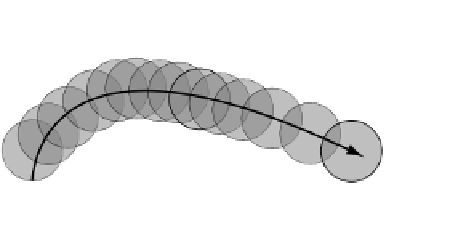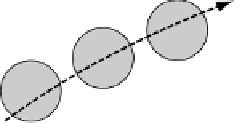Geoscience Reference
In-Depth Information
Suspension
trajectory
Grain lifted aloft by
turbulent
burst
Flow
z
Saltation trajectory
Lift
Resultant
x
Drag
Lift off
Gravity
Pivot
angle
Turbulent
burst
Impact
Fig. 4.38
Grain motion and pathways.
4.8.3 Some contrasts between sediment transport in
air and water flows
differential motion of the fluid over an initially stationary
boundary. Working from dynamic principles Bagnold
assumed that
1
In order to move a layer of stationary particles, the layer
must be sheared over the layer below. This process involves
lifting the immersed mass of the topmost layer over the
underlying grains as a
dilatation
(see Section 4.11.1), hence
work must be done to achieve the result.
2
The energy for the transport work must come from the
kinetic energy of the shearing fluid.
3
Close to the bed, fluid momentum transferred to any
moving particles will be transferred in turn to other sta-
tionary or moving particles during impact with the loose
boundary; a dispersion of colliding grains will result.
The efficacy of particle collisions will depend upon the
immersed mass of the particles and the viscosity of
the moving fluid (imagine you play pool underwater).
4
If particles are to be transported in the body of the fluid
as suspended load, then some fluid mechanism must act to
effect their transfer from the bed layers. This mechanism
must be sought in the processes of turbulent shear,
chiefly in the bursting motions considered previously
(Section 4.5).
The fact that fluids may do useful work is obvious from
their role in powering waterwheels, windmills, and tur-
bines. In each case flow kinetic energy becomes machine
mechanical energy. Energy losses occur, with each machine
operating at a certain efficiency, that is, work rate
Although both air and water flows have high Reynolds
numbers, important differences in the nature of the two
transporting systems arise because of contrasts in fluid
material properties. Note in particular that
1
The low density of air means that air flows set up lower
shearing stresses than water flows. This means that the com-
petence of air to transport particles is much reduced.
2 The low buoyancy of mineral particles in air means
that conditions at the sediment bed during sediment
transport are dominated by collision effects as particles
exchange momentum with the bed. This causes a fraction
of the bed particles to move forward by successive grain
impacts, termed
creep
.
3
The bedload layer of saltating and rebounding grains
is much thicker in air than water and its effect adds signif-
icant roughness to the atmospheric boundary layer.
4
Suspension transport of sand-sized particles by the
eddies of fluid turbulence (Cookie 13) is much more
Table 4.3
Some physical contrasts between air and water flows.
Material or flow property
Air
Water
Density,
(kg m
3
) at STP
1.3
1,000
Sediment/fluid density ratio
2,039
2.65
avail-
Immersed weight of sediment per unit volume (N m
3
)
2.6
10
4
1.7
10
4
able power
efficiency. Applying these basic principles to
nature, a flow will try to transport the sediment grains
supplied to it by hillslope processes, tributaries, and bank
erosion. The quantity of sediment carried will depend
upon the power available and the efficiency of the energy
transfer between fluid and grain.
Dynamic viscosity,
(Ns m
2
)
1.78
10
5
1.00
10
3
Stokes fall velocity,
V
p
(m s
1
) for a 1 mm particle
~8
~0.15
Bed shear stress,
zx
(N m
2
) for a 0.26 m s
1
~0.09
~68
shear velocity
Critical shear velocity, u
*c
, needed to
0.35
0.02
move 0.5 mm diameter sand

















Search WWH ::

Custom Search